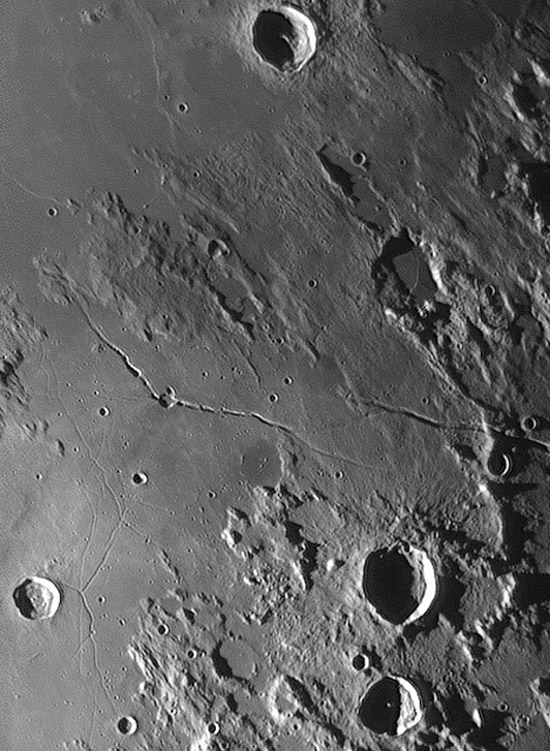Difference between revisions of "December 24, 2012"
| (5 intermediate revisions by the same user not shown) | |||
| Line 1: | Line 1: | ||
__NOTOC__ | __NOTOC__ | ||
=Annual Image= | =Annual Image= | ||
| + | <!-- Start of content --> | ||
<!-- ws:start:WikiTextHeadingRule:0:<h1> --> | <!-- ws:start:WikiTextHeadingRule:0:<h1> --> | ||
| + | <table class="wiki_table"> | ||
| + | <tr> | ||
| + | <td><!-- ws:start:WikiTextLocalImageRule:14:<img src="/file/view/LPOD-Dec24-12.jpg/394434046/LPOD-Dec24-12.jpg" alt="" title="" /> -->[[File:LPOD-Dec24-12.jpg|LPOD-Dec24-12.jpg]]<!-- ws:end:WikiTextLocalImageRule:14 --><br /> | ||
| + | </td> | ||
| + | <td><em>image by [mailto:waddington50@earthlink.net Bruce Waddington]</em><br /> | ||
<br /> | <br /> | ||
| + | The December 2012 issue of <em>Sky and Telescope</em> includes an article comparing my observations of the Hyginus area with those of classic observers of the 19th century. Bruce read it and submitted this image with a note: <em>Even though I’m an avid deep-sky imager, I always make it a point to image the Moon at least once a year. And when I take off the camera gear and actually look through the scope, I always try to do it when the Moon is up. I agree with you on that, there is really nothing like taking your time and carefully looking at an interesting area of the Moon. Anyway, my 2011 lunar image happened to include the Rima Hyginus area, and the K-shaped rille pattern you described showed up very nicely. So I’ve attached the image, just for grins.</em> For an infrequent lunar observer Bruce's image is quite good, so I think we should all encourage him (in the comments section) to up his rate of lunar imaging from once a year to once a month. It will certainly be faster for him than his [http://cs.astronomy.com/asy/m/galaxies/488020.aspx?utm_source=SilverpopMailing&utm_medium=email&utm_campaign=ASY_NonSub_news_120713_final&utm_content= 8 hour exposure] for some galaxies.<br /> | ||
| + | <br /> | ||
| + | <em>[mailto:tychocrater@yahoo.com Chuck Wood]</em><br /> | ||
| + | <br /> | ||
| + | <strong>Technical Details</strong><br /> | ||
| + | 11/27/2010 from a dark-sky site near Anza, CA . It’s a composite image taken with the 10-inch Meade SCT at f/11 using the Imaging Source DMK 21AF04 camera through an H-alpha filter.<br /> | ||
| + | <br /> | ||
| + | <strong>Related Links</strong><br /> | ||
| + | Rükl plate [https://the-moon.us/wiki/R%C3%BCkl_34 34]<br /> | ||
| + | <em>[[21st Century Atlas of the Moon|21st Century Atlas]]</em> chart 12.<br /> | ||
| + | <br /> | ||
| + | <hr /> | ||
| + | <br /> | ||
| + | <!-- Removed reference to store page 2 --> | ||
<p><b>Yesterday's LPOD:</b> [[December 23, 2012|Blue Moon]] </p> | <p><b>Yesterday's LPOD:</b> [[December 23, 2012|Blue Moon]] </p> | ||
<p><b>Tomorrow's LPOD:</b> [[December 25, 2012|Comments?]] </p> | <p><b>Tomorrow's LPOD:</b> [[December 25, 2012|Comments?]] </p> | ||
| − | <!-- | + | <!-- End of content --> |
{{wiki/ArticleFooter}} | {{wiki/ArticleFooter}} | ||
Latest revision as of 08:25, 28 October 2018
Annual Image
 |
image by Bruce Waddington
Yesterday's LPOD: Blue Moon Tomorrow's LPOD: Comments? COMMENTS?Register, Log in, and join in the comments.
|



